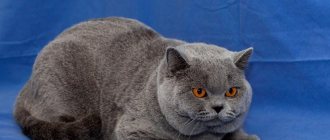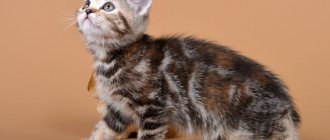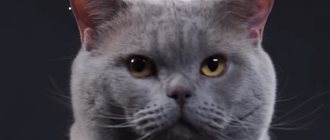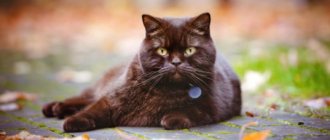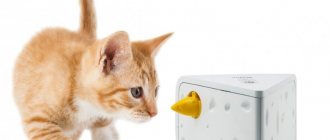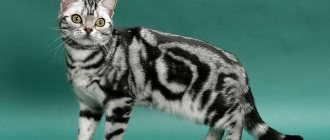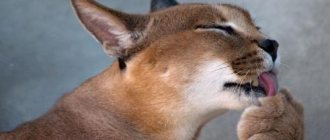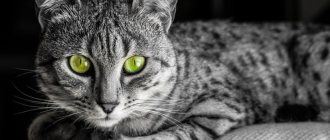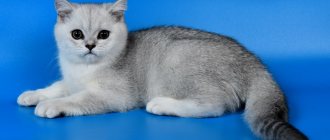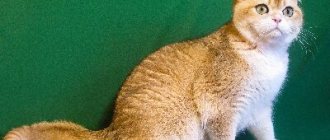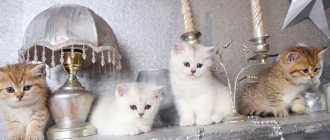Blue color in British cats photo
The blue British cat is the embodiment of comfort and tranquility in the house. Large with cute faces and velvet-soft fur, they charm the whole family. It is simply impossible not to love such animals with an imperturbable character, neat, affectionate and self-sufficient, unobtrusive. They resemble the famous Cheshire Cat from the children's fairy tale "Alice in Wonderland" filmed in the Disney cartoon based on the story by L. Carroll.
Chocolate
You might think that most black cats turn chocolate over time, but this is not true. Babies, whom nature has endowed with such a shade, have a deep tone in childhood, but not very saturated. The beautiful chocolate shade makes itself felt in six months. The color is so monotonous that sometimes it is impossible to describe it in words. Breeders say that the cost is affected by the depth of color. In some countries, chocolate Britons are also called chestnut or havanna.
Description of color
The British blue cat is famous for its appearance, its beautiful fur coat in gray-blue tones. The British are called blue solid because of the monochromatic color, which is recognized as classic, extending to the skin, coat, head, limbs, and tail.
The coat is smooth, dense, velvet-like, covering the entire body evenly. The spectral range of color is light gray, deep blue, and dark graphite. Each hair is painted from base to tip with an even, shiny light or medium dark color. Inclusions and stains are unacceptable according to the standard.
The photo clearly shows that blue-colored Britons are recognizable not only by the description of their color and appearance; they cannot be confused with other cat breeds, thanks to their characteristic features:
- The body is not large, but powerful, muscular, with considerable weight, which can reach up to 6 kg in females and up to 8 kg in males.
- The head is round in shape and covered with the same color of hair with widely spaced, small, erect ears above a large, flat forehead.
- A distinctive feature of the muzzle is the large, slightly drooping cheeks. Between them is a short, slightly flattened, wide nose. The whisker pads are round and convex in shape. The chin looks powerful, the neck has a characteristic thickened ridge.
- The wonderful muzzle is emphasized, making it expressive, by large round orange-copper eyes with a dark gray outline around them.
- The beautiful body ends with a short fluffy tail.
a cat and a cat are distinguished by aristocratic manners and have a calm character. They do not irritate the owner with excessive intrusiveness, are self-sufficient, and can entertain themselves. They are loyal to their owner, but can easily tolerate long separations. An intelligent, well-trained breed, clean and litter box trained since childhood.
- Monitor your health, get vaccinated according to schedule, and treat for helminths in the spring and fall for prevention;
- Brush daily with special brushes against the growth of the bristles, and then so that the fur and undercoat are freed from dead hair, giving it a fluffy, shiny appearance;
- Wash your eyes daily with the Diamond Eyes solution, clean your ears with a swab once a week;
- Bathe rarely, when soiled, with special dye-free shampoos with natural ingredients;
- Feed with balanced “super premium” food from reliable companies.
Contents of a Black Briton
British cats are a fairly easy-to-care breed; if properly maintained, British cats can easily live up to 15-16 years of age without causing much trouble to the owner. Therefore, the key points that the cat owner should know are mainly related to the animal’s nutrition.
Feeding a British cat
The owner of the animal can choose two feeding options - natural food or a diet consisting of high-quality dry food. It is impossible to mix two types of diets, as this is fraught with gastrointestinal problems for your pet. If we talk about industrial ready-made food, then you need to choose the “super-premium” or “holistic” lines, if possible selecting the specific breed of food. Many brands offer food made and selected specifically for the British breed.
Royal Canin for British cats
However, modern food is not necessarily selected strictly for the breed - it is better to focus on the characteristics of the animal (homebody, castrated or sterilized animal, walking on the street, and so on). Each pack contains a table from which you can easily find out the daily dosage of food for a Briton - just weigh the animal and follow the manufacturer’s recommendations.
British cats are prone to obesity, so you should not overfeed your pet or leave food freely available.
An adult should be fed twice a day, morning and evening; the rest of the time there should be only clean, cool drinking water in the bowl - this is important!
To prevent your cat from suffering from excess weight, the serving size needs to be adjusted.
The natural nutrition of a British cat is based on fresh raw meat (turkey, veal, rabbit are preferred). There is no need to boil the meat, in which case it loses its beneficial properties, just pour boiling water over the piece before cutting and immediately offer it to the cat.
Food from the master's table is not suitable for the British; there is no need to cook porridge or soups for the cat - they negatively affect the digestive system of the predator. To raw meat you can add grated raw vegetables (pumpkin, carrots, zucchini), quail or chicken eggs, and finely chopped herbs. Every day a cat eating natural food should receive kefir or cottage cheese. You need to remember that in terms of the amount of protein, curd mass is equivalent to meat, and balance the diet based on this - an excess of protein “hits” the liver.
Fresh meat should occupy at least 60% of a small predator's bowl
In addition to meat, dairy products, vegetables and herbs, British cats should receive additional mineral and vitamin supplements - high-quality complex vitamins can be purchased at a pet pharmacy (Canina, 8 in 1, Beafar, Polidex).
British black cats benefit from adding a little kelp seaweed to their daily dose, which maintains and maintains the bright charcoal color of their coat. Dietary supplements for cats containing kelp are also sold in pet stores.
Treats with kelp for cats
Black British coat care
The short but thick coat of a British cat requires some attention from the owner - once a week the cat needs to be thoroughly combed with a slicker brush with droplets on the tips of the teeth or with a special massager. During the molting period, grooming procedures should be carried out more often - once every two days, carefully combing out the dead undercoat. A kitten must be taught to brush itself from a very early age, otherwise a wayward adult cat may resist.
British cats are washed once every six months, or when soiled, if the animal has access to the street or spends the summer season outdoors. For washing, special shampoo for animals should be used. For black Britons, we recommend lines of cosmetics designed specifically for dark coats: “Royal Groom Black Pearl”, “Ring 5 – Black Out”, “Kiss Black Bagheera” and the like.
The British are clean and do not need to be bathed often
General Content Rules
Like any cat, the British cat must regularly undergo the following procedures: annual vaccination and quarterly deworming treatment. If your pet has access to the street, during the spring-autumn season you need to treat it against ticks and also wear a flea collar. Also, cats walking outside should have a separate thin collar on which will hang a tag with the owner’s phone number.
Cats must be vaccinated
Origin of color
The first British cat of Blue color appeared in 1871 and took first place at a cat show. The cat was introduced by breeder Harrison Ware. The appearance of the Briton charmed fans, but only in 1950 did she gain recognition in American felinology.
For over a hundred years, breeders have worked to achieve the perfect standard of the British Blue. To achieve the result, they were mated with various breeds of cats: Persian, French, and blue Russian cat. It has been established that the recessive Blue tone is a diluted black pigment. Therefore, the color varies over a wide spectrum from dark graphite to light gray, rich blue. Now certain standards have been established for the color of the breed; according to color, it is rated up to 25 points.
Breeders have difficulties with breeding; according to the rules of genetics, this is a recessive color and two Blue parents can produce the same kittens of both sexes. When mating with other colors, it is difficult to get blue kittens.
Eyes
Not only the beautiful, soft, shiny coat evokes admiration, but also the charming, large, round eyes. They are widely spaced relative to the nose, which gives them more expressiveness. The coat color of a British cat looks good in the photo in combination with their eyes, which are copper, orange, and golden.
Due to the yellow color of the eyes and the gray-blue color of the coat, the pure British cat is sometimes confused with a mixed breed from a Russian cat, but they are distinguished by the shape of the head and the full cheeks characteristic of the blue solid.
Content Rules
Proper care of an adult pet or kitten will preserve and prolong the health of the animal. British cats need regular coat care: combing, bathing, grooming. The fur of cats of this breed is thick and short, and the animals themselves are very clean and groom themselves thoroughly. But they need to be combed to get rid of lost hair and to add shine and shine to the coat. The cat licks the fallen hair and swallows it.
Hairs collect in the stomach in clumps and cause discomfort, this can lead to serious illnesses. Therefore, pets should be combed regularly and given special medications to prevent the accumulation of hair in the body.
It is also necessary to clean the ears and nose and trim the nails once every few weeks. You can help wash your cat's eyes daily. The teeth of the British also need to be monitored and periodically given special dry food for tartar. In addition, purebred individuals are susceptible to many genetic diseases.
How to get color
Initially, the black pigment eumelanin was chosen to obtain the blue color. Which is equally present in black and gray cats, but in the latter it is distributed sparsely and unevenly throughout the fur, this creates a dilution of coat color with the participation of the recessive gene D. This biological effect explains the presence of various shades in the British cat breed from blue, light to graphite. Breeders are well aware of the rule of genetics:
- male kitten - obtained from a blue parent;
- the kitten is a girl when both parents are blue.
The subtleties of breeding work lie in the correct selection of the parent pair. To obtain light gray tones, you can attract lilac and cream individuals of lightened colors.
Kittens
In the photo, the British blue cat and her family look very beautiful, their fur is shiny, dense, and velvety, especially in kittens. They look like small, funny bear cubs.
Up to a year old, the kitten's undercoat color has dark shades, and moire may appear on the tail. Cream shade, bicolor in color are unacceptable.
A British cat appears with blue eyes, growing after 3 months they acquire a copper, orange or gold color. The kittens' paws and nose match the main tone, gray.
Features of British hair care
There are also some differences regarding the hygiene and living conditions of black British cats.
- British fur coat color can vary depending on diet. For example, food containing beets is suitable for dark-colored cats. But a large amount of seafood on a cat’s menu can negatively affect the color of the paws and nose - these areas of the body will become lighter, in contrast to the main shade.
- When exposed to ultraviolet light, a black cat's fur becomes dull and takes on a gray tint. To restore color, you will have to limit the time your pet stays in direct sunlight.
Despite the short hair, the British cat needs regular brushing during shedding. The procedure is carried out several times a day using a special mitten or comb.
Who is the color suitable for?
A traditional British cat with a blue color in its disposition, manners, cleanliness, and independence is suitable for:
- For lonely people, she will become a pliable, affectionate, loyal friend.
- For large families with children, she will make friends with everyone.
- For busy people who are not at home for a long time, she will not be very bored or mischievous, and will calmly wait for her owner.
Advantages and disadvantages
Striking in appearance with its beautiful, velvety, noble, blue-gray fur, the British cat has gained recognition due to its amazing character. Positive qualities include:
- unobtrusive;
- independent, self-sufficient
- does not require special care;
- experiences loneliness with dignity;
- balanced;
- clean;
- trainable;
- has a healing, calming effect.
There are no negative qualities, except for a fairly high price for a kitten; financial investments are required for maintenance. But a noble, intelligent pet will appear in the house, the joy and pride of the whole family.
Source
Marbled or wild
Marble color is a silver or white coat with dark stripes on top. Often the drawings are large in size. Very often, representatives of this color are called “snow leopards.” Some animals have stripes so uneven and large that it looks like the cat is two-colored. In recent years, not only light-colored cats have become marbled. The main tone can be chocolate, black, blue. On the “golden chinchilla” you can even find similar spots.
Animals belonging to a breed with this color have several subspecies, according to which they differ:
- We are talking about van - the main color is white.
- Bicolor - an animal with large white spots on its fur.
- Miteda - representatives with white paws, as well as a light-colored stripe from the chin to the groin.
- Tricolor is a tortoiseshell color with three shades, which necessarily includes white.
- Harlequin - a large white spot on the fur.
A little history of the breed
They are one of the oldest known breeds, descended from European domestic cats imported to England at the same time as the Roman invasion in the first century AD. Today it remains the most popular breed in its native country, as registered by the UK Governing Council for Cat Fancy (GCCF).
The origins of the British Shorthair most likely date back to the first century AD, making it one of the oldest identifiable breeds in the world.
It is believed that the Roman invasion originally brought Egyptian domestic cats to Britain. These animals were then interbred with the local European wild cat population. Over the centuries, their natural isolated descendants evolved into very large, robust beasts with short but very dense hair, to better withstand the rather harsh climatic conditions of their home islands. Based on artists' views, the modern British Shorthair is no different from this original type.
On the left you see blue colors. On the right are the tabby, red, cream and cinnamon varieties in the first photo, tortoiseshell in the second and bicolor in the third.
Selective breeding of the best specimens of this breed began in the nineteenth century, with an emphasis on developing an unusual blue-gray variant called the "British Blue" or "English type" (to distinguish it from the finer-grained "Russian").
Some sources directly credit British artist and cat lover Harrison Weir with the original concept for standardizing the breed. Others suggest that a group of breeders was involved in the selection.
The new British Shorthair was introduced at the first ever cat show, organized by Weir at the Crystal Palace in London in 1871, and enjoyed great initial popularity.
By the 1890s, with the advent of newly imported Persians and other longhair breeds, the British Shorthair was no longer as widely popular, and its breeding stock became critically rare during the First World War.
At least partly to save the breed, breeders mixed Persians with their bloodlines. The genes introduced in this way would eventually become the basis of the British Longhair. At that time, any longhaired cats produced were included in the Persian breeding program, as all blue cats were then rated together as non-de facto single breed options. Blue Shorthairs, the result of crossing the early British with Russian Blues, were also common.
After the war, in an attempt to maintain the breed standard, the GCCF decided to accept only third generation Perso-British Shorthair crosses for registration. This also contributed to the destruction of the pure breeding stock by the beginning of World War II, after which the Persian and Russian Blue were reintroduced to the list of acceptable crosses.
Blue kitten
In addition, felinologists have also worked with the French Chartreuse, another ancient breed that, although not genetically related to the British Blue, is very similar visually. Breeders devoted much attention to restoring the true English type, and by the late 1970s the British Shorthair had received official recognition from both the Cat Fanciers' Association (CFA) and the International Cat Association (TICA).
It is again the most popular cat breed in the UK, according to the GCCF 2013 registry.
Tabby
The British tabby is some kind of color mix, since the animals can have a golden or silver background, and can resemble a color point shade. On the body of adult animals there are often bright stripes or spots, like a leopard. Babies are brindle or spotted. This is not a deviation from the norm.
Spotted Britons are usually confused with other breeds, but they are distinguished by their eye color, as well as the shape of their ears and habits. In addition, the British have the most dense wool that representatives of the presented breed can boast of.
Brief description of British cats
The British Shorthair is a rather powerful-looking large cat with a wide chest, strong thick legs with rounded paws and a medium-length tail with a blunt tip. The head is relatively large and rounded, with a short muzzle, wide cheeks (most noticeable in mature males, which tend to develop prominent jaws) and huge round eyes, which are dark copper-orange in British Blues and in others cases vary in color depending on the coat. Their ears are large and set wide apart.
The British Blue variant can often be confused with the Gray Scottish Fold. However, in shorthairs the difference can be characterized by the presence of sharp triangular ears, while in Scottish cats they are soft and folded.
The animals mature slower than most cat breeds, reaching full physical development at approximately three years of age.
Unusual among domestic cats, they are a noticeably sexually dimorphic breed, with males averaging 4.1–7.7 kg and females 3.2–5.4 kg.
The British Shorthair is one of the defining characteristics of the breed. It is very dense, but has no undercoat. Thus, the texture is soft rather than downy or fluffy, with a hard, "fresh" coat that visibly "breaks" throughout the cat's body as it moves.
British Blue is still the most familiar variety, however British Shorthairs have been sectioned into many other colors and patterns. Black, blue, white, red, cream, silver, gold and, more recently, the cinnamon (cinnamon) and fawn colors are accepted according to all official standards, either solid or colored, tabby, shaded and two-tone.
Felinological associations GCCF, FIFe and TICA also accept the color chocolate and its diluted shade lilac, prohibited by the CFA standard. All colors and patterns also have tortoiseshell options.
Tabby patterns include the following varieties:
- Classic tabby;
- Tabby Mackerel;
- Spotted and tabby marked.
Non-tabby patterns include the types:
- Turtle cake;
- Two-tone bicolor;
- Two-tone with white;
- Smokey tuxedo;
- Color-point.
British Blue Cat
Temperamentally, this is a calm and dignified breed, not as active and playful as many others, but good-natured and devoted to their owners, which makes them favorite trainable pets.
They are generally safe around other pets and children, as they will tolerate a fair amount of physical interaction, but generally do not like to be picked up or carried. They require only minimal care and are easy to keep, however, they can be prone to obesity if care is not taken with diet.
The English Breed Committee considers the British Shorthair to be a long-lived cat with a life expectancy of 14-20 years. Data from veterinary clinics in England shows an average of 11.8 years. According to Swedish statistics, the average life expectancy of the breed is more than 12.5 years. 82% of British Shorthairs lived to 10 years or more, and 54% to 12.5 years or more.
British breed standard
To figure it out for sure, you need to delve into the approved British standard and at least approximately understand what a worthy representative of the breed should look like.
When choosing a black kitten, the future owner must be sure that he is purchasing a British cat, and not a cat with a similar phenotype.
Table 1. External features of British cats
| Parameter | Description |
| Head | As the British say: “The whole breed is in the head.” Indeed, British cats are distinguished by a characteristic large head, round in shape, with wide cheekbones and pronounced “chubby” cheeks. The forehead is round and flat, the nose is short and straight. |
| Chin | Strong, massive, straight (perpendicular to the mirror of the nose). The British jaw should not be narrowed or thin. |
| Ears | Small, low set, rounded at the tip. A Briton's ears should be at an angle of ninety degrees to each other, if the apex of the angle falls on the bridge of the animal's nose. |
| Frame | Short, squat, muscular. Both male and female cats are distinguished by their massiveness, but not looseness. The animals are distinguished by a wide chest and powerful hips. |
| Limbs | Medium length, thick and strong. |
| Tail | Wide at the base and rounded at the tip. Medium length, quite thick. |
| Eyes | Large, wide-set and open. The iris of British cats reaches its final shade quite late, perhaps by the animal’s year. |
| Wool | Thick, dense and shiny, with good undercoat. Ideally, a Briton's fur coat should resemble stuffed plush, so that the animal's skin is not easy to touch. |
What should/shouldn't the head of a thoroughbred Briton look like?
Colors of British Shorthair cats
The British Shorthair is England's favorite cat, and it's easy to see why: its large, muscular body, loving but often whimsical temperament, and array of colors and patterns mean it's a breed suitable for many lovers.
Some British Shorthair colors are very well known, but the variety has many excellent color isomorphs and patterns, and new types are emerging all the time.
British merle color
There is a huge variety of British Shorthair colors.
Black color group
The British "Bagheera" is divided into different types:
- Black British Shorthair. An animal with the right characteristics is a real beauty - expressive amber eyes looking out from a deeply pigmented black background always remind one of the black panther from The Jungle Book. This is an amazing cat of extraordinary beauty.
- British Blue is also part of the black group of solid colors and is the best known color for this breed. This is a rather misleading description because "blue" is actually grey. It's easy to see why this is such a popular shade, with its wonderful muted steely tones. British Blue is an instantly recognizable beauty. All blue cats are actually genetically black cats with an additional breeding gene that reduces the amount of pigment in the fur, creating a blue/gray tint to the coat.
- British shorthair chocolate color. The deep rich color is incredibly unusual and loved by many people.
- The British Shorthair "lilac" has a very unusual and beautiful coat color, lilac is a very warm gray. This is actually a chocolate cat with a dilution gene that reduces the pigment in the fur and makes the chocolate a bluish tint.
- The Cinnamon British Shorthair is a relatively new color in the breed and is similar to chocolate but with a warmer, reddish tint.
- Fawn British Shorthair is also one of the new colors. Fawn is a cinnamon with a dilution gene that makes the pigment less concentrated and creates a very soft deer hide color. The fur is very similar to lilac, but a little softer and more subdued.
Red British Shorthair
While all other colors come from the black gene, red and cream, its diluted colors, are independent.
All ginger cats will have some sort of stripe markings visible, but a show animal should have as few visible line markings as possible.
A rich, deep red is the most desirable color in the competition, but it can range from pale red to deep burgundy.
The Cream British Shorthair should be a lovely light brown shade with no hint of ginger. Cream is a diluted red gene, so it is difficult to achieve beautiful cream cats without red undertones.
White British Shorthair
The white gene is an additional allele that lies on top of other patterns and has the effect of masking color shades, making the fur light.
All white cats are essentially genetically colored animals, but with a white gene.
British shorthair patterns
The term Selfs is used to describe any British Shorthair of one solid color.
In addition to solid colors of different shades and colors, this breed has various groups of coat patterns:
- Tortoiseshells. Only female British Shorthairs can be Torties because this gene is linked to sex. The tortoiseshell cat has one gene for black and one for red, both of which are visible in the fur. Black cakes - black and red, blue - blue and cream, chocolate - light cinnamon and red, lilac - lilac and cream, brown - cinnamon and red, fawn - fawn and cream. The ideal British Tortoiseshell should have a beautiful mixture of two different colors throughout the coat, creating a mottled effect.
Blue cake
Blue cake
- Bicolor. Bi-colored British Shorthairs are very colorful cats. They can be any color and are accompanied by white markings, which are usually found on their face, belly and paws, but the markings sometimes appear anywhere on their body. Bicolored Britons can be less than 50% white or more, depending on their genetic makeup. The white spot allele is different from the white gene. The latter prevents the pigment from spreading throughout the body while the kitten is still in the womb.
- Calicos are tri-colored cats based on bi-colored tortoiseshells. The white spotting gene influences the tortie's pattern, causing it to appear in marks of color rather than fine spotted markers throughout the coat.
- Color point. Such Britons can come in any possible color of the breed. The "color point" gene prevents the development of color on warmer parts of the body (higher temperature), and the effect of this phenomenon is that the animal's limbs, tail and face are darker in color than the body (points).
- Tabby. In fact, all cats are tabby, but there is a gene that hides the tabby pattern. Striped animals do not have this additional allele. British shorthair Tabbies come in a variety of colors including silver, gold, blue, lilac, cinnamon and fawn, and can also be color-pointed or bi-colored.
Black
Charcoal-colored pets are incredibly beautiful. The black shimmers mesmerizingly in the light, giving the fur coat some incredible and inimitable shade. Black Britons have been rare in recent years. This is due to a sharp change in shade at six months to one year of age. Babies that are born may be “tar”, but over time the color changes to chocolate or brown. It turns out that initially the breeders believe that they managed to acquire “little devils,” but later it turns out that these are completely different beauties.
Some black cats have chocolate or dark (close to black) undercoat in some places. It is unacceptable. Such pets look very beautiful and unusual, but the animals are already classified as two-colored and cannot in any way be called charcoal.
When buying a black cat, you need to be prepared for the fact that in the future the shade of its fur will change and your furry friend will have a different fur coat.
Ideal British Shorthair eye color based on coat color
Speaking about the colors of the British Shorthair breed, it is worth mentioning the shade of the eyes in each category, as this is very important for the correct assessment of the animal.
Below is a table of the correspondence of the shade of the cornea of the British Shorthair's eyes to the fur color.
| Eye color | Wool shade |
| Orange, amber, gold | Black and blue. |
| Cinnamon (cinnamon) and fawn. | |
| Blue | Color-point colors. |
| Green, brown, orange, amber, gold | Silver tabby. |
| Green, blue, orange, colorful | White. Eye color is determined by the amount of pigment in the iris. If there is a lot of it, the cornea will have an orange tint, while in the complete absence it will have a blue tint. Green and yellow tones lie somewhere in the middle of these two extremes.
A dilution program that does not take eye color into account ultimately results in a dilution of the desired shade, with all corneal tones shifting toward the middle of the spectrum and ending up yellow or green. Look at the handsome blue-eyed Briton Kobe: British Blue eye colorBlue British Shorthairs have been bred widely and over a long period of time, so the characteristics of the British Blue color have a fantastic opportunity for development. The result is many blue British Shorthair cats with a fantastic orange eye tint, although this is a very difficult color to breed.
Shorthair British Chocolate LilacChocolate and lilac colors have recently been introduced in this ancient breed.
As a result, it is much more difficult to find chocolate or lilac British Shorthairs with exceptional orange eye color: most "chocolate" and "lilac" have irises of yellow or amber shades. Although some breeders managed to get incredibly orange eyes from lilac shades of color. Cinnamon and fawn British Shorthair colorCinnamon and fawn coat colors have appeared more recently, and the eye color of these animals is similar to the shade of “chocolate” and “lilac”, but less developed and not as rich. Color Point British ShorthairFor breeders of English cats of this color, the goal is to have the eyes as blue as possible and this is a very difficult task.
Most colorpoints have silver-blue eyes. They are incredibly beautiful in their own right, and many people actually prefer silver tones over bright blue.
Silver irises have very little pigment. Professional breeding and eye color of the British ShorthairUltimately the eye color that is preferred in an animal is a personal choice of the breeder and will obviously not affect the purity and beauty of the breed.
A good experienced breeder will be able to help the client choose their most suitable kitten. British Shorthair kitten - correct eye coloringAll British Shorthair kittens are born with blue eyes. Gradually, as they grow older, they acquire their true color. This transition begins when the cubs are about 6-8 weeks old and continues until they are about 2 years old, when they finally reach their full colors. For example, a blue British Shorthair kitten is born with blue eyes, and these will then change color to a variety of shades, including dirty brown and green, before the color is fully developed.
|
Contents of a Black Briton
Contrary to popular belief that the British are difficult to look after, the reality is completely different. If you follow simple rules of care, a four-legged animal can easily live up to 18, and sometimes 20 years.
There are just a few nuances that you should pay attention to.
Namely:
- Avoid hypothermia of animals and do not place their houses in drafts. Representatives of these breeds have weak eyes. Therefore, at the slightest breath of wind, their eyes begin to water and sour.
- Visit a veterinarian regularly, especially for owners of animals over 10 years old, and get vaccinated.
- Feed your cats correctly.
- Do not allow frequent matings (for cats), this weakens the immunity of fluffies, they begin to get sick often.
Caring for cats involves proper feeding. This can be high-quality dry food or canned food, as well as natural food.
First you need to decide, and then carefully select your diet. If preference is given to dry food, then it is better to choose the holistic or super-premium lines. Many brands offer food specifically for the British, taking into account their age.
At the same time, veterinarians advise choosing food based on the four-legged lifestyle. If the animal is overweight, then it is worth purchasing appropriate food. If the cat does not leave the house, therefore, it is necessary to purchase appropriate food. It's all written on the packs. In addition, veterinarians working in specialized pet stores will always give advice and help, so this will not be a problem.
Some owners worry that their British black kitten will go hungry while they are at work. Therefore, they leave the drying directly in the bowl, pouring it with a mountain. This cannot be done because, firstly, the feline’s stomach will quickly stretch out, and secondly, they will get used to the fact that they can eat as much as they want, and then they will not leave their feeder. Considering that the British are prone to obesity, doing this is strictly prohibited.
Animals must be given eggs at least a couple of times a week. The same applies to dairy products. True, there should not be an excess of them. To maintain the charcoal shade of the coat, you can add kelp to your food from time to time. If the cat is repelled by the smell, then it is worth buying vitamin complexes that contain these algae and giving them.
You should forget about food from the table. British black cats, like representatives of other colors, begin to get sick if they consume fat, salt and spices in excess. All this is present in the food that a person eats. All this is prohibited for animals.
Grooming
Many people believe that the British Shorthair black cat's coat does not need to be looked after. However, it is not. If the animal is not combed at least once a week, the hairs will begin to tangle and cough. Therefore, this procedure cannot be avoided. To do this, it is better to buy a soft brush that will not injure the skin.
Cats should not be bathed frequently. If the animal walks along the street, then “bath days” must be organized 2 times a year. For bathing, you should take shampoos designed specifically for black Britons. These cosmetics are sold in pet stores.
